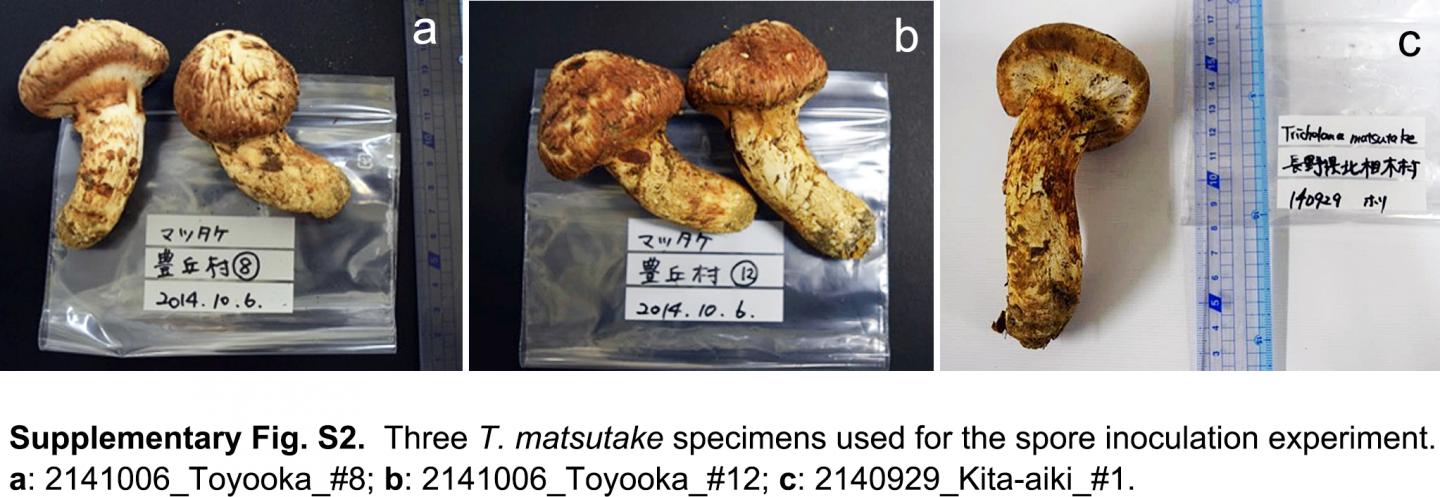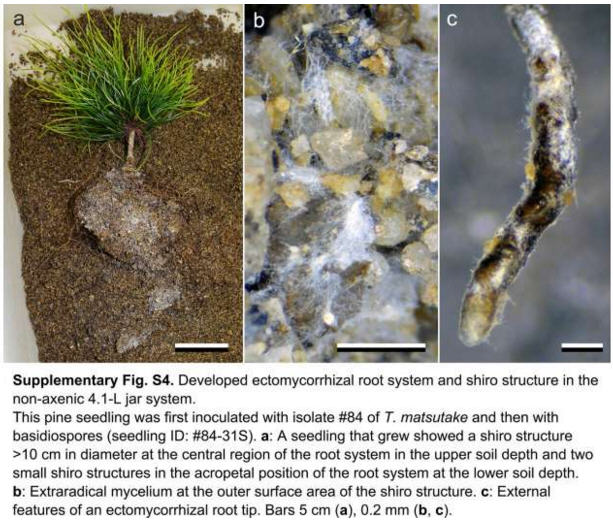博文
人工培养珍贵的食用菌——松茸
 精选
精选
||
人工培养珍贵的食用菌——松茸
诸平

Image: Three T. Matsutake Specimens Used For The Spore Inoculation Experiment. View More
Credit: Copyright © 2021, Akiyoshi Yamada Et Al., Under Exclusive License To Springer-Verlag Gmbh Germany, Part Of Springer Nature

松茸(Tricholoma matsutake)是珍贵的食用菌之一,根据质量的不同,每只蘑菇的价格从15美元到70美元不等。在日本,松茸因其清香而备受推崇,常与米饭或汤一起煮,被视为秋日美食。然而,没有办法培育松茸,而且随着气候变化,有利于松茸生长的森林越来越少,自然形成的栖息地正在减少。据日本信州大学(Shinshu University)2021年4月14日提供的消息,该校研究人员对其可以进行人工培养。上述图S2(Fig. S2)是用于孢子接种实验的3个孢子标本的图片。相关研究结果于2021年3月24日已经在《菌根》(Mycorrhiza)杂志网站发表——Yuka Horimai, Hiroki Misawa, Kentaro Suzuki, Yu Tateishi, Hitoshi Furukawa, Takashi Yamanaka, Shozo Yamashita, Toshiharu Takayama, Masaki Fukuda, Akiyoshi Yamada. Spore germination and ectomycorrhizae formation of Tricholoma matsutake on pine root systems with previously established ectomycorrhizae from a dikaryotic mycelial isolate of T. matsutake. Mycorrhiza, Published: 24 March 2021, DOI: 10.1007/s00572-021-01028-3. https://doi.org/10.1007/s00572-021-01028-3
通讯作者、信州大学农学系、生物科学与生物技术系和山地科学研究所(Institute for Mountain Science)的山田明义(Akiyoshi Yamada)教授以及其他9位研究人员着手提出具体证据,证明松茸孢子发芽,到达寄主的根部并共生后代这开始了新的共生。参与此项研究的除了日本信州大学的科研人员之外,还有来自日本长野县森林研究中心(Nagano Prefectural Forest Research Center)、森林与森林产品研究所(Forestry and Forest Products Research Institute)以及KOA公司(KOA Corporation)的研究人员。
当松茸孢子萌发时,其亲本所在土壤中的菌丝诱导萌发,并在寄主根系上形成一个遗传多样性的群体。因此,研究者假设下一代可以在保持多样性的同时被创造出来。信州大学的实验将松茸(matsutake mushrooms)与日本红松(Japanese red pine)置于容器中培养,将从户外采集的松茸子实体中获得的孢子接种发芽,从而成功地在日本红松的根部建立了新的菌丝。
研究人员通过人工控制自然界中松茸的代际变化,成功地使松茸孢子萌发。他们希望在森林里建立一种人工栽培松茸的技术。由于本研究在实验系统中引入了新鲜的松茸孢子,除非附近有松茸供应,否则本研究很难开展。换句话说,可以说这项研究发现最有效地利用了信州大学农学院的地理位置,让世界上最有价值的野生食用菌——松茸的孢子萌发。
虽然伞形毒菌(Deathcap Amanita)激增,但警告不要选择或食用野蘑菇(Australians warned to not choose or eat wild mushrooms as Deathcap Amanita proliferates)。上述介绍仅供参考,欲了解更多信息敬请注意浏览原文或者相关报道。
In vitro ectomycorrhizal synthesis of Tricholoma matsutake with host plants has been widely conducted to elucidate fungal symbiotic properties for future cultivation practices. Here, we report on the importance of basidiospore inocula for this fungus to provide ectomycorrhizal seedlings in vitro. Ectomycorrhizal pine seedlings synthesized in vitro with cultured mycelium of T. matsutake (isolate #45 or #84) in a 250-mL culture vessel (soil volume) were transplanted to a large 1-L culture vessel. Fresh basidiospores of this fungus were aseptically inoculated on the ectomycorrhizal root system. The ectomycorrhizal seedlings in the 1-L vessel were grown for 9 months, and some plants were further grown for 6 more months under non-aseptic conditions in 4.1-L jars. The ectomycorrhizal seedlings previously inoculated with isolate #84 in the 1-L vessel showed significant ectomycorrhizal biomass (mycorrhizal root length) after spore inoculation. The ectomycorrhizal seedlings in the 4.1-L vessel showed large shiro structures (> 10 cm in diameter). PCR amplification of intergenic spacer 1 of the rRNA gene and long terminal repeat retroelement of T. matsutake in ectomycorrhizal root tips in both the 1-L vessels and 4.1-L jars revealed the presence of amplicons of the previously inoculated culture isolate of T. matsutake and the new genet(s) that established via germination of the inoculated basidiospores. This is the first report that inoculated basidiospores of T. matsutake germinated and colonized the host root to generate ectomycorrhizae in vitro.
https://blog.sciencenet.cn/blog-212210-1282172.html
上一篇:科学家们在气溶胶粒子中发现了3种液相
下一篇:3D超导材料中为何会自发出现2D电子水坑?